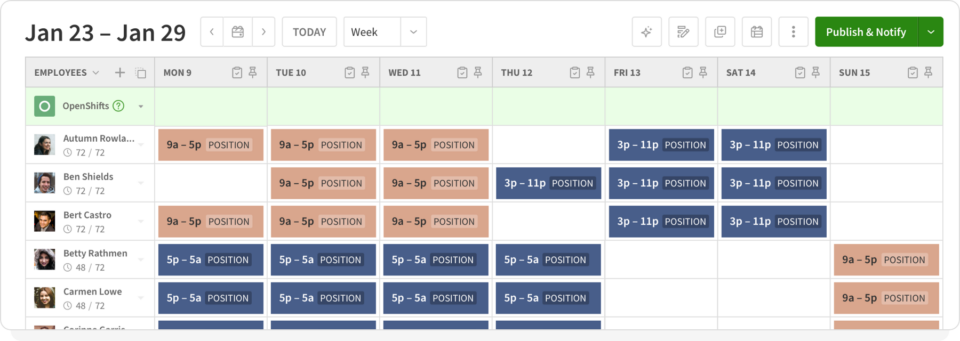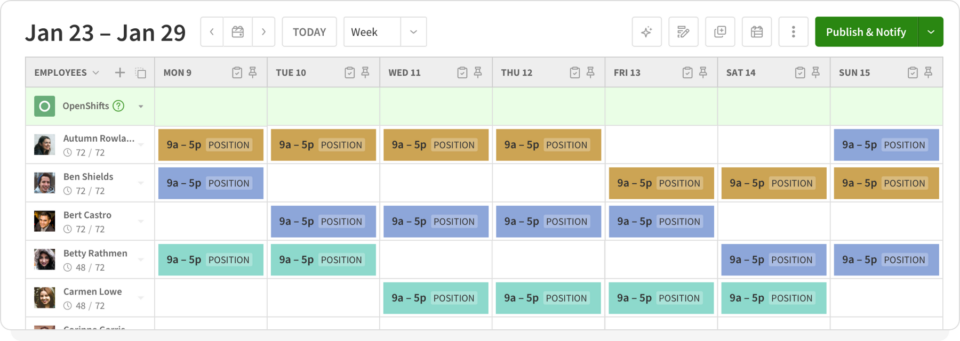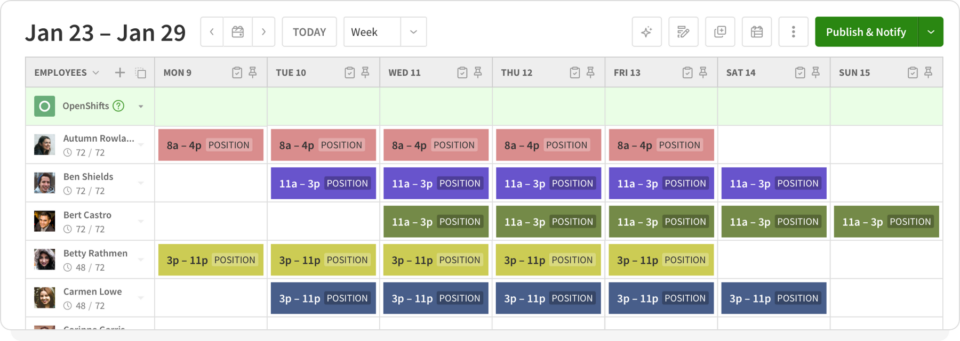Creating A 24-Hour Schedule: Tips, Examples, And Templates
Try When I Work for free
If your doors never close and the lights never go off, you’re always on and always open.
That means you’re dealing with a 24-hour shift schedule, and while your customers probably appreciate the convenience of being able to come to your place of business any time of day or night, that 24-hour availability can take a lot of work to plan for.
Night shifts can be demoralizing to your team, and to avoid this, equity is the rule of the game. Yet swapping and rotating 24-hour shifts can be difficult mentally and physically for those trying to adjust. And, as the manager, a full 24 hours of customer interaction varies widely from peak traffic to just a trickle. That’s hard to plan for yet you have to be adequately staffed for all of it.
With a 24-hour shift schedule, your team may get a chance at larger chunks of days off in a row, avoid traffic and commute headaches, and have the ability to run errands during times of the day when others are working.
But there are cons, too. It’s difficult to maintain relationships, with social life often being limited to other employees, and the physical demand of working days and then nights can create sleep disorders. Lethargy and depression are common. For those with family, it can create strain in the home.
It’s possible, despite all of that, to make a 24-hour shift schedule that is equitable to your employees, taking their needs into consideration, while still meeting customer demand. We’ll show you how to make this schedule work for everyone while minimizing scheduling conflicts and reducing burnout and employee turnover.
Key takeaways
- Planning a 24-hour shift schedule requires balancing business needs, customer traffic patterns, and employee availability and preferences.
- There are different types of shift schedules, such as fixed shifts, rotating shifts, swing shifts, and days on, days off plus shift rotation, each with its own benefits and challenges.
- Implementing equitable shift rotations can reduce employee burnout and turnover.
- Tools like When I Work can automate the scheduling process, offering options like templates and shift swaps to make 24-hour scheduling more manageable.
- Input from employees and understanding their needs is crucial when designing a shift schedule.
Want to build your 24-hour shift schedule 8X faster? Sign up for your free 14-day trial of When I Work to get started today!
Before building a 24-hour schedule
24 hours is a lot of time to work with, and consequently, there are a variety of ways to build the shift schedule. There’s no right or wrong way to do it; it depends on what’s best for your unique team.
We’ve listed the most important factors for you to consider to help you choose the shift schedule that’s right for your staff.
What type of business do you have?
The employee needs and management expectations of a restaurant are completely different from a hospital or a manufacturing facility. The questions you ask, in order to figure out the best 24-hour shift schedule, will vary depending on that.
A hospital might be asking questions about seasonal patient census and weekend emergencies. A manufacturing facility will be concerned with production demands as well as scheduled maintenance and taking equipment offline. A restaurant is concerned with customer traffic. A security company may need more personnel on hand during low traffic times, the opposite of many other kinds of businesses.
What kind of availability can your staff offer?
How many employees do you have? What kind of availability does each have?
Some of your employees can offer you more hours than others, depending on their personal situation. Instead of assuming everyone is the same across the board, speak to employees. Ask them about their availability.
Some of the 24-hour shift schedules you can use are better suited for larger numbers of employees; if you have a small staff, those are off the table for you.
What does your sales data tell you?
When planning your 24/7 shift schedule, you absolutely need to know your customer traffic patterns. When are you the busiest? When is it slow? What kind of customer needs happen at different times of the day? Are you offering delivery services?
For example, if you’re a 24-hour restaurant, perhaps your late night customers are more interested in coffee and pie, and you might be able to turn off the grill, not schedule kitchen staff, and only offer basic counter services for those late-night shifts instead. Perhaps you’ll only offer delivery services at peak hours.
What business resources do you have to offer?
Can you afford overtime pay? Can you offer higher pay for those working the night shift, or less desirable shifts?
It’s a good idea to have these numbers on hand before you start choosing a 24-hour shift schedule, because you may need enticements to fill out some of those late shifts. Offering extra pay if you can’t afford it is a bad idea, so know where you stand beforehand.
What do your employees prefer?
Potentially working at any hour of the day or night is going to create concerns and strong preferences in your employees.
What do your employees want? Can you get their input and get them involved in the schedule in some way so they feel like they have ownership over it? Do they want rotating shifts? Do they want 8-hour or 5-hour shifts? You may have laws requiring 8-hour shifts, but if you don’t, ask your team.
While it might seem easier and quicker to make the decision on your own, it’s a decision that’ll have a significant impact on your employees’ personal lives. Getting their feedback isn’t only the smart thing to do, it’s the right thing to do.
What kind of flexibility will you offer?
Flexible self scheduling is popular for shift work, but you need to plan for it if you’re running a 24-hour shift schedule.
Will you allow employees to switch their shifts and schedules with each other? If so, how will you manage it so that you know you have needed coverage for each shift, not just in total employees, but in required skills? How will you make sure that employees are taking shifts that won’t end in burnout or sleep problems later?
You’ll want to be sure to use scheduling tools that allow you to set up restrictions and guidelines so that, even if employees can swap shifts with each other, it’s done within your policies.
How will paid time off factor in?
How does employee paid time off factor into your schedule?
Any time off, including calling in sick, can throw your schedule into chaos. While paid time off is something you can plan with your employee, it’s still going to leave a gap in your crew. If you plan a 24-hour shift schedule that maximizes every single employee, the absence of just one will put you in a bind.
What practices do you need to avoid?
The most tempting thing for many managers struggling to fill out their schedules is to assign a clopening shift.
Don’t do this.
The clopening shift is the closing shift the night before and the opening shift the following morning, and it’s brutal on employees.
Yes, you’re 24-hour, but some places who lay claim to 24-hour do have a closing procedure before they gear up for the new day, while others actually do close down for a short time in the early morning to clean and reset.
Even if you’re a true 24-hour business, scheduling someone to work the evening shift and the early morning shift, with the overnight shift handed to someone else, is still a bad idea. Sleep deprivation, mental and physical health, and general burnout are what you’ll create in employees if you use clopening shifts.
There should be no schedule containing a late night/early morning back-to-back shift for any employee, even if they claim they don’t mind.
Looking to learn about different shift schedules? Keep reading or watch our YouTube video and learn about the various types of rotating shift schedules, determine which is right for you, and how to create a more balanced schedule that benefits your employees and your business.
24-hour schedule coverage examples
Shifts can vary in how you arrange them across a week, and how you arrange them across a day. Let’s take a look at a few shift examples that might work for you, so you can begin shift planning like a pro.
Fixed shifts

The easiest route is to hire people for specific shifts. That means they’ll always work the same shift and there are no surprises.
Shifts are hired and staffed according to the customer demand that occurs on those shifts. In businesses where there are customer spikes during part of a shift, part-time workers can fill the void.
This makes it easier for you to schedule, and some employees prefer it because their body doesn’t have to constantly readjust to changing day and night shifts. Customers get used to dealing with the same staff when they come in at the same times of the day. But for employees who do not like the shift they are on, they won’t get a chance at any other shift. They may look for work elsewhere.
Fixed shifts work well for any size business, but keep in mind that employees need time off. You need more employees than the bare minimum to cover all shifts and account for those who have time off.
Rotating shifts

Rotating shifts are more equitable in that they allow employees the chance to work all of the different shifts. No one gets all of the “good” shifts, and no one is stuck with the “bad” shifts.
Rotating shifts can be:
- Constant. The shifts are rotated in a short time span (e.g. week). This can be hard on employees, physically and mentally.
- Slow. Shifts are rotated much more slowly, even over months at a time, so employees can adapt to the change.
- Weekend. Employees take turns working weekend shifts, common in smaller businesses who don’t have the staff to cover it otherwise.
- Partial. Some employees have a fixed shift schedule, but others rotate.
Rotating shifts work with medium or large businesses, particularly if you’re mixing the kinds of rotations.
Swing shifts

Common in businesses that need steady output or coverage, swing shifts allow for different starting and stopping points for employees each day instead of a set start-stop for every employee in a shift.
For example, instead of shifts that run 8-4, 4-12, 12-8, there would be shifts that are 9-5, 11-7, and so on, mixed in there.
They can be mixed with standard fixed shifts so there’s an employee on hand to carry over one shift to the next for smoother transitions. Some employees like the challenge of swing shifts, and it helps them keep from getting bored working the same shifts and times. Others prefer regular shifts they can plan their calendar by.
Swing shifts require a larger employee base because there’s a lot of staggered shifts; that also makes it trickier to schedule.
Days on, days off, plus shift rotation

Mix shift rotation with how you structure the work week, and you’ll solve a lot of equity issues.
Let’s use this 24/7 shift schedule example that could be broken up into five days on, two days off.
Structuring the day into three shifts (day shift, middle shift, and night shift) that are eight hours each, an employee works five days, and then has two days off. The next week, the schedule moves so that their two days off adjust one day over in the week. Every seven weeks, the schedule would be back where it started.
Because it’s not a good idea to flip an employee back and forth between day and night shifts too often (it disrupts sleep patterns), you could give an employee the day shift for seven weeks, the middle shift for seven, and the night shift for seven. Or, you might split it up if employees don’t want seven consecutive weeks on one shift.
This approach works with a staff of 15 or more (to ensure coverage in all of the rotation). Alternative versions would be four days on, two days off (36 or more employees), five days on, three days off (40 or more), and so on.
You essentially have two moving pieces for every employee: which week they’re on, and which shift they’re on. Managing all of these alternating weekly and shift schedules is best done with an employee scheduling tool that allows for templates.
This approach is equitable in that everyone gets a chance to work the days and shifts that are desirable and undesirable. It also gives them consecutive days off to refresh. If your business requires specific skill sets on some shifts, however, this approach may not work as well.
24-hour scheduling template
When I Work makes this easy for you (and fair for your employees) by giving you automated tools to build such a schedule. Once you build out the schedule that works for your business, you can save it as a template and use it over and over again. With templates and shift swaps, you can build the work schedule faster and easier than ever before. Plus, self scheduling controls lets you empower your employees to create a schedule that works well for them while still getting the coverage you need.
Easier employee scheduling with When I Work
As you can see, managing a 24-hour shift schedule can be complicated. It’s no longer just about the days of the week someone is working, but the times of the days of that week. Sign up for a free trial today, and find out how you can turn a 24-hour shift schedule nightmare into a dream.
FAQs: 24-hour shift schedule
Q: How can I plan for a 24-hour shift schedule?
A: Planning a 24-hour shift schedule involves assessing your business needs, understanding customer traffic patterns, and considering your employees’ availability and preferences. It’s important to use a strategy that promotes equity among employees and minimizes burnout.
Q: What are the different types of 24-hour shift schedules?
A: There are various types of 24-hour shift schedules including fixed shifts where employees always work the same shift, rotating shifts which allow employees to experience all different shifts, swing shifts that have different starting and stopping points for employees each day, and a mixture of days on, days off, plus shift rotation. The days on, days off option offers a lot of variety, like 4 days on and 3 days off, 2 days on and 2 days off, or even 1 day on and 2 days off.
Q: What tools can help me manage a 24-hour shift schedule?
A: Scheduling tools like When I Work can help automate the 24-hour scheduling process. These tools offer features like templates, shift swaps, and self-scheduling controls, making it easier to build and manage your work schedule.
Q: How can I make a 24-hour shift schedule more equitable for my employees?
A: Consider using rotating shifts, which allows every employee to experience all the different shifts. Additionally, involve your employees in the scheduling process and consider their preferences. Avoid practices like “clopening” (closing one night and opening the next morning), which can lead to employee burnout.






